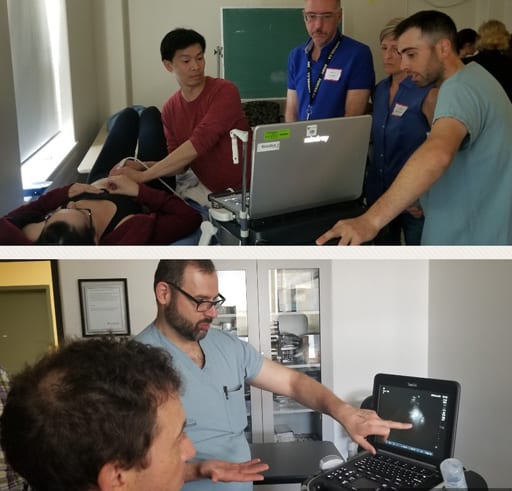Photo above: SRH anesthesiologists take an advanced course in assessing cardiac and lung function in patients under anesthesia using point-of-care ultrasounds.
It’s a sunny Saturday afternoon in mid-June and while many are enjoying an early summer-like day, Scarborough and Rouge Hospital (SRH) Anesthesiologist Dr. John Oyston and eight of his colleagues are learning critical skills that will significantly advance the way they provide patient care.
On June 16, these physicians took an advanced course to begin implementing point-of-care ultrasounds (POCUS) to assess cardiac and lung function in patients under anesthesia.
“Like all physicians at SRH, the Anesthesiology team is committed to offering the latest techniques and technology to deliver the very best care to patients in Scarborough,” stressed Dr. Oyston, who is also Interim Chief of Anesthesia at SRH’s General site.
“We’re proud to be one of the first community hospitals in Ontario to begin using POCUS technology to monitor and assess cardiac and lung function in patients during surgery. It will allow us to determine the exact cause of any problems, and enact the best treatment.”
Point-of-care ultrasounds are units that are brought to the patient and can be used to determine everything from internal bleeding, to how the heart is pumping, to the location and health of a fetus.
Dr. Oyston notes that ultrasound technology has been helping anesthesiologists to deliver safer care for many years now.
“We use ultrasounds to help us place central lines, the large intravenous catheters that go in the big blood vessels in the neck and around the collar bone. It allows us to see where the blood vessels are, and to watch as we put the needle into the vein, which makes the whole process much safer.
“Anesthesiologists also use ultrasounds to improve accuracy and patient comfort when we inject local anesthetic. Similar to central lines, ultrasounds allow us to see the actual nerve we want to “freeze’. The freezing works better, lasts longer, and we can use a lower dose of the drug, which means there’s less risk of serious side effects.”
In addition, Dr. Oyston points out that POCUS helps anesthesiologists give exactly the right amount of intravenous fluid to patients throughout their surgery.
Outside of the operating room, SRH is also a leader in the use of POCUS in the Emergency department (ED). The organization is one of the only community hospitals in the province to run a fellowship program for ED physicians to be trained in advanced POCUS skills. As well, the majority of ED physicians are fully trained and certified in Canadian Emergency Ultrasound Society standards.
What’s more, every ultrasound scan performed in the ED is reviewed by a physician who has completed this advanced ultrasound training; a leading practice among hospital EDs.
“Without a doubt, point-of-care ultrasounds have proven benefits when it comes to patient care and are where the future of emergency medicine lies,” said Dr. Sachin Ramkissoon, an ED physician at SRH and ED Ultrasound Director.
“Doing the scan right in the ED at the bedside means increased patient safety, reduced time to diagnosis, and improved patient satisfaction.”
“SRH is fortunate to have such a talented and passionate team of physicians who are dedicated to delivering world-class patient care, as well as sharing their knowledge to help advance the medical profession,” said Dr. Dick Zoutman, Chief of Staff at SRH.
“Their commitment is helping us to shape the future of care for our community.”

